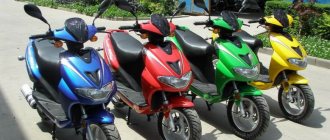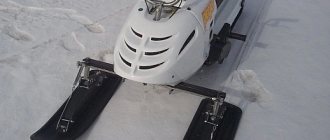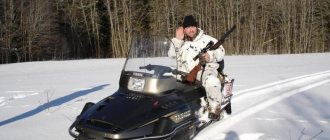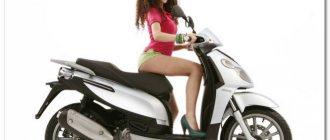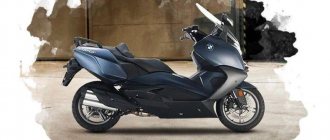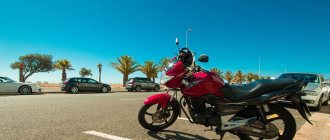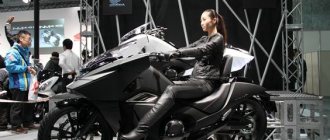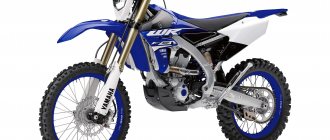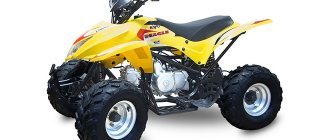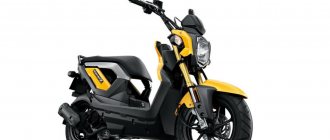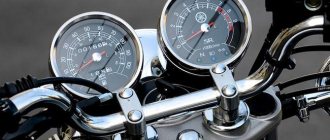Two or four?
A snowmobile is one of the few types of motorcycles where two-stroke engines occupy a very strong position. The fastest and most maneuverable snowmobiles are two-stroke. Their main advantage is low weight with high power. With the development of technology, two-stroke engines are becoming more advanced, they have learned to install an injector on them, oil consumption is decreasing, and snowmobiles no longer leave a trail of smoke and soot behind them.
Four-stroke engines are heavier, so they are mainly used in utilitarian and tourist equipment. Their advantages are cleaner exhaust, no need for frequent oil filling (replacement only), smooth performance throughout the entire speed range.
MY MOTORCYCLE
Summer is already over and soon most of the bikers will hide their iron horses in garages (some will even drag them into their houses/apartments) and the sad time of waiting for the new season will come. But not everyone finds this time uninteresting - there is a type of bikers - winter ones. Guys who winterize their bikes and ride on. Or, if possible, replace it with a snowmobile. It is about them that we will discuss in the future, or rather what types of snowmobiles there are. Like bikes, they also have a classification - each according to its purpose:
1. sports, 2. mountain, 3. hybrid (combination of sports and mountain), 4. tourist, 5 . utilitarian (working) and 6. children's.
Children's snowmobiles do not seem to differ much and their power characteristics are made weaker, just for children aged 9-13 years. Well, of course, the sizes are smaller.
But it’s worth understanding the different types of adult snowmobiles in more detail.
- Sports snowmobiles
Sports (trail) snowmobiles are intended primarily for sports, for racing and competitions. Almost all of their functions play in favor of one, the most important characteristic - speed. Such snowmobiles have a powerful and responsive engine and energy-intensive suspension. At the same time, they weigh relatively little and have poor cross-country ability (simply because they don’t need it, they are made for other purposes). In addition, a distinctive feature of sports snowmobiles is their short (compared to other types of such machines) track - no longer than 3070 mm. These snowmobiles are good for driving on smooth, compacted trails or on the flat ice of lakes.
Sports snowmobiles also often do not have such convenient and important functions in everyday life as electric start and reverse gear. They are difficult to ride on unpacked and deep snow. Finally, sport snowmobiles are always single-seaters. But they have the already mentioned strong point - speed. On a good road they can accelerate to almost 200 km/h.
2. Mountain snowmobiles
Mountain snowmobiles are also designed for fast driving, but in conditions that are no longer flat, but rough terrain. Unlike sports ones, they are also capable of driving well in deep snow. Since a mountain snowmobile with good cross-country ability needs to maintain high-speed characteristics, it provides itself with increased cross-country ability not only and not so much by the width of the track, as is usually the case, but also by its length and the size of the track hooks.
However, the longer the track, the less maneuverability of the snowmobile. Therefore, while outperforming sports snowmobiles in cross-country ability, mountain snowmobiles definitely lose to them in maneuverability. In addition, a long track increases the weight of the snowmobile; therefore, mountain snowmobiles are always heavier than sports ones. Finally, mountain snowmobiles, like sports snowmobiles, are single-seat.
3. Hybrid snowmobiles
Some companies, for example, Yamaha or Arctic Cat, offer so-called hybrid devices that combine the advantages of a sports and mountain snowmobile. Very suitable for those who find it difficult to choose between these two options. Hybrid snowmobiles differ from sports snowmobiles, first of all, as a rule, by a longer (but not as long as mountain) track (it can also be wider, but rarely).
4. Touring snowmobiles
A touring snowmobile is a machine for those who prefer a comfortable ride in easy conditions. If you don’t travel far, if you need it for quiet family entertainment, and not necessarily on deep virgin snow, then a tourist snowmobile is your choice.
They come with a variety of engines, but are almost always heavy, not particularly fast, without outstanding characteristics in terms of cross-country ability, but they are always two-seaters. At the same time, it is also worth emphasizing that touring snowmobiles are usually the most comfortable - they have the most comfortable seats, the most luggage compartments and all sorts of pleasant functions. 5. Utilitarian (work) snowmobiles
Utilitarian (working) snowmobiles (they are also called whitetrucks - from the words wide track - wide caterpillar) - they are designed for transporting goods in deep snow and different terrain - they are universal workhorses. They have the best cross-country ability on the plain, even in the deepest snow, a very wide track and a lot of luggage compartments. Practically, a snowmobile-truck or even a tank. No one can compare with utilitarian models for driving through the forest, for example. Such snowmobiles almost always have a tow bar and can pull a trailer of significant weight (500 kg of cargo or four to five passengers). The only parameters in which they lose to their counterparts of other types are dynamism and speed.
Wide trucks are slow machines, they practically never accelerate above 120 km/h, and they rarely fly at such maximum speeds. At the same time, we can say unequivocally - if a snowmobile is needed for business, and not for entertainment, then this is definitely a utilitarian model. Well, or mountain, if you live or work in rough terrain and very deep snow, and you need to drive rather than carry loads.
Another interesting fact is that recently in the world of snowmobiles (as, indeed, in the world of cars and other equipment), consumers increasingly prefer more universal, as if mixed, models. For example, two-seater models of sports snowmobiles have already become easily available. When choosing a snowmobile of a certain type, you definitely don’t have to clearly say that it will have the features of its type and will not borrow certain characteristics from other types. There is no longer a clear division into types, and we can only talk about the predominance of features of one or another type in one or another specific model.
How many skis for a snowmobile?
For many years in our country there was only one type of snowmobile known, with one ski and two tracks. This design lost its relevance even before the collapse of the USSR. The vast majority of modern snowmobiles have two skis and one track. They handle much better, they do not require a medium-sized field to turn, and the level of comfort is incomparably higher. The driving performance of a snowmobile with a traditional two-ski design is greatly influenced by the type of front suspension. The telescopic one is more difficult to break, it can withstand strong impacts and can be operated under heavy load. The wishbone suspension provides excellent handling and comfort.
This is the only option for sports equipment and the most common for tourism equipment. But when driving on difficult terrain with rocks and trees, you need to be careful not to bend or break the levers. The design of the shock absorbers also affects comfort and handling. The presence of adjustment mechanisms usually indicates a high level and allows you to adjust the snowmobile to the type of terrain, load and driving style.
Short story
The first functioning snow sled engine was developed and put into operation by the famous French polar explorer J.-B. Charcot, French automobile pioneer, Marquis Jules-Albert de Dion and engineer Georges Bouton. The drive had to be driven by an internal combustion engine, a drum on the snow surface with numerous crossbars and teeth. At the same time, Briton Robert Scott, preparing for an expedition to the South Pole, also turned to De Dion Bouton to develop a motor sleigh based on the design of a Norwegian sleigh called the “Nansen sleigh.” Testing of these vehicles took place in the spring of 1908 in the area of the Lautaret Pass in the Dolphin Alps.
The first Soviet snowmobile
Probably the first motor sleds equipped with an aerosan (special propeller) were built by the Russian scientist A.S. Kuzin in 1908. Almost at the same time, the aerosan was built by the young I. Sikorsky in 1909-1910. In parallel, attempts were made by the United States to adapt the famous FordModelT car for winter driving, but it was not until 1924 that the American inventor and designer Carl Eliason made his first functional prototype of a snow car. In 1927, Alison's scooter was patented - this design is used today virtually unchanged, only for economic reasons, changing the parameters of the vehicles. os.
Tracks for a snowmobile. Short, wide or long?
To make the snowmobile more passable, larger tracks are used. On utilitarian models, the contact patch is larger due to the width, as eloquently evidenced by, for example, the name Polaris Widetrak, which has become a household name. Mountain snowmobiles require good maneuverability. Therefore, they are equipped with long, high-profile tracks, which allow sharp turns in deep snow due to the low inclination. On compacted snow, a snowmobile with a small caterpillar is best controlled; these are the ones used on cross-country and touring models.
Design features
At its core, a snowmobile is a motorized sled that is driven by a high-speed engine, that is, a motor similar to a motorcycle engine. The snowmobile is controlled using steering handles connected to the skis in front.
The steering wheel has a throttle actuator (gas lever) and a brake lever, which allow you to control the speed and braking of the car. Instead of rear wheels, it has a solid rubber belt like a caterpillar track. The belt, connected to the engine by gears, a chain and a belt, propels the snowmobile (picture above).
Modern closed snowmobile
Snowmobiles are very mobile and agile. Not only can they travel at speeds of over 85 mph, but they can also climb slopes as steep as 65 degrees. However, a middle-class car is capable of climbing inclines no steeper than 20 degrees.
Snowmobiles can travel through spaces that are inaccessible to ordinary cars, which is exactly what they are designed for. Due to the larger area of contact with the surface, the pressure exerted on the snow is several times less, and the friction force is higher.
Therefore, they are often used to deliver goods and any assistance to harsh areas where there are few roads and a lot of snow. But most often people use a snowmobile just for fun.
Even state leaders ride snowmobiles
The snowmobile engine pistons rotate the primary clutch. Then the belt drive transmits this rotation to the secondary clutch, which is located on the intermediate shaft. A chain is attached to the far end of the intermediate shaft, and it already rotates the axis of the two driving gear drums. These drums fit into the sockets of the snowmobile's solid rubber band. As the reels rotate, they pull the tape forward. The transmission mechanism of this machine is designed in such a way that, depending on the speed of its movement, snow cover and type of terrain, the amount of energy transmitted to the belt changes.
It's in the details
Ride quality is affected not only by large components, but also by small parts. If you plan to ride for a long time with a passenger, a soft double seat with heated handles will not hurt. High glass is useful for comfort, but during active driving the snowmobile sometimes tips over and breaks, so on sports equipment the glass is either low or absent altogether. A high handlebar is good for broken trails where you have to stand up, a low handlebar is good for relaxed, seated riding.
If there is work, hunting or fishing ahead, you will need a loading platform and, possibly, a tow bar for the sled. In general, a huge amount of additional equipment for snowmobiles is sold, so the machine can be adapted to almost any need.
You can choose a snowmobile that suits your needs through the official Brandt dealer network.
tell friends
Price
The design and narrow purpose of snowmobiles make a snowmobile an expensive pleasure. Prices vary significantly depending on the brand, country of manufacture, age of the unit and the presence of additional functions. Thus, a domestic snowmobile, which has been “out” for several seasons, will cost $500–1,500; a new Russian model, for example, “Buran” or “Lynx,” will cost around $5,000. Prices for used equipment of foreign brands start from $2,000 for those options that have been “on the road” for 3–4 seasons and from $2,500 for those that have been in use for 1–2 winters. New children's snowmobiles can be purchased for $3,000 to $3,500. To purchase “adult” models, you should be prepared to spend from $4,500 for a simple package. Maximum additional features and parts, of course, along with the snowmobile itself, will cost between $7,000 and $10,000.
Choosing and purchasing a snowmobile is a responsible matter, so it is better to seek advice from specialists, for example, representatives of a equipment distributor. If you want to buy a good snowmobile, pay attention to the leading brands on the market.
No. 1 Budget (Trail)
If you are a novice driver, care about comfort, make truly informed purchases and do not belong to the advertising-dependent class, a budget option for you is the ideal choice of snowmobile. It's great for leisure trips.
Such snowmobiles are created for those who have just begun to get acquainted with this type of transport. Affordable price is its main advantage. If you ride it a couple of times and then decide that such trips are not for you, it will not be a big blow to your finances. It is relatively light in weight, stable and safe for the driver. It features a comfortable suspension and guarantees almost complete safety when cornering. However, keep in mind that this snowmobile is designed for flat terrain and is not suitable for hilly terrain.
Photo gallery
As we have already said, collapsible snowmobiles are comfortable, reliable and compact, easy to disassemble, and also easy and quick to assemble, without requiring any effort. When disassembled, it fits into the trunk of a car. We bring to your attention a photo selection of the models discussed in our article.
